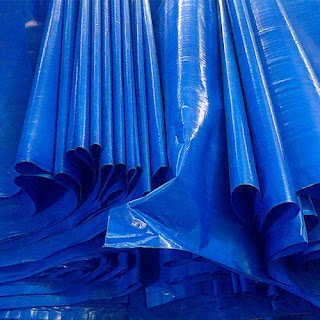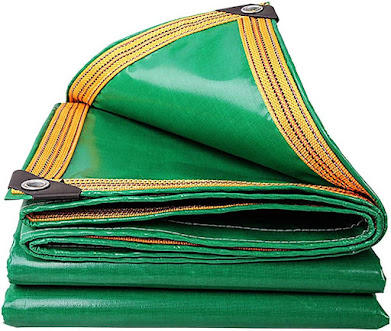Uses of PVC Tarpaulin in Garden
Introduction
The garden, often viewed as a desert spring of peacefulness and a material for inventiveness, is a space that demands insightful maintenance and protection. Among the different materials accessible for safeguarding and enhancing the garden climate, PVC Tarpaulin arises as a flexible partner. This engineered material, produced using polyvinyl chloride (PVC) covered texture, has tracked down a large number of utilizations in gardening, providing a consistent mix of usefulness and feel.
Waterproof Shelter for Plants:
One of the essential uses of PVC tarpaulin in the garden is to offer a protective safeguard against the impulses of climate. Be it unnecessary rain, scorching sun, or startling hailstorms, PVC tarpaulins can be utilized as waterproof covers for fragile plants. These covers go about as a boundary, preventing overabundance dampness from reaching the plants' foundations and shielding them from brutal daylight, eventually contributing to better and more strong growth.
Greenhouse Construction:
For gardeners with a propensity for cultivating plants past their normal territory, PVC tarpaulin is invaluable in constructing improvised greenhouses. The material's adaptability and strength make it a magnificent decision for crafting temporary or semi-extremely durable greenhouse designs. These greenhouses assist with creating a controlled climate, fostering the growth of plants that could not in any case flourish in the neighborhood environment.
Seasonal Protection:
Gardens are dynamic spaces that develop with the seasons. PVC tarpaulins play a vital part in facilitating this change by providing seasonal protection. During colder months, they can be decisively positioned over weak plants, acting as insulating covers that trap intensity and safeguard against ice. In hotter seasons, similar tarpaulins can be reused to offer shade, preventing unreasonable intensity and sun harm.
Customized Plant Nurseries:
PVC tarpaulin's pliability and solidness make it an optimal candidate for crafting customized plant nurseries within the garden. These mini-nurseries fill different needs, from germinating seeds to cultivating sensitive plants in a controlled climate. The adaptability of PVC tarpaulin permits gardeners to plan and set up these nurseries in various shapes and sizes, catering to the particular necessities of the plants within.
Protective Ground Cover:
Past sheltering plants from a higher place, PVC tarpaulin finds utility as a ground cover, offering protection to the garden bed. At the point when laid underneath the dirt, it goes about as a boundary against weeds, preventing their intrusive growth and reducing the requirement for consistent weeding. Furthermore, the tarpaulin fills in as insulation, preserving soil dampness and maintaining a favorable climate for plant roots.
Rainwater Harvesting Systems:
Chasing sustainable gardening rehearses, PVC Tarpaulin can be ingeniously reused to gather and reap rainwater. By decisively placing the tarpaulins across raised surfaces, they can channel rainwater into capacity containers. This collected rainwater turns into an important asset for watering plants during droughts, contributing to water protection efforts within the garden.
Decorative Awnings and Canopies:
Gardens are about usefulness as well as style. PVC tarpaulin, accessible in various varieties and plans, can be transformed into decorative awnings and canopies. These give shade and protection as well as add a dash of style to the outside space. Whether it's a dynamic covering over a seating region or a rich awning adorning a garden pathway, PVC tarpaulin flawlessly combines common sense with visual allure.
DIY Plant Containers and Grow Bags:
In the soul of sustainable gardening, PVC tarpaulin can be reused for DIY plant containers and grow bags. The material's adaptability takes into consideration simple shaping, and its solidness guarantees a long life expectancy for these ad-libbed containers. This imaginative utilization of tarpaulin gives an affordable and eco-accommodating option in contrast to customary plant pots, encouraging creativity in garden plans.
Temporary Fencing and Enclosures:
Gardens often require temporary fencing or enclosures for different reasons, like protecting explicit regions during construction or keeping out undesirable bugs. PVC tarpaulin, with its solidness and adaptability, can be designed into ad-libbed fencing. These can be effortlessly installed and destroyed on a case-by-case basis, offering a flexible answer for creating temporary garden limits.
Artistic Garden Murals:
For those with a style of innovativeness, PVC tarpaulin can be transformed into artistic garden murals. This involves painting or printing outwardly appealing plans on the tarpaulin, turning it into a useful yet stylishly pleasing component in the garden. These murals can be decisively positioned to improve explicit regions, adding a customized touch to the outside space.
Conclusion
The uses of PVC tarpaulin in the garden are pretty much as different as the plants that inhabit this green safe haven. From protecting against the components to fostering controlled conditions and promoting sustainable practices, PVC tarpaulin ends up being an invaluable resource for gardeners. Its versatility, strength, and stylish potential create it a material whereupon both the commonsense and inventive parts of gardening can prosper. As gardens continue to develop and mirror the remarkable characters of their overseers, PVC tarpaulin stands as a solid sidekick, prepared to adjust to the consistently changing requirements of the plant safe house.




Comments
Post a Comment